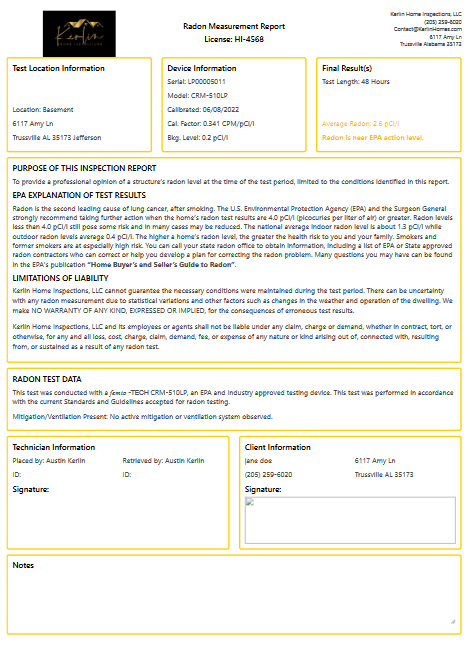Radon Information
Radon is the number-one cause of lung cancer among non-smokers, according to EPA estimates. Radon is the second-leading cause of lung cancer. Radon is responsible for about 21,000 lung cancer deaths every year. About 2,900 of these deaths occur among people who have never smoked. In 2005, the U.S. Surgeon General issued a national health advisory on radon. Radon is dangerous because it radioactively decays into a number of products. These decay processes are energetic enough to cause damage to tissue and DNA. Radon is also ubiquitous, and can easily become concentrated in basements or other poorly ventilated areas. Radon concentrations greater than 4 pCi/L are considered to be in need of remediation.

Radon is a cancer-causing, radioactive gas.
You cannot see, smell, or taste radon but it may still be a problem in your home. When you breathe air containing radon, you increase your risk of getting lung cancer. In fact, the Surgeon General of the United States has warned that radon is the second leading cause of lung cancer in the United States today. If you smoke and your home has high radon levels, your risk of lung cancer is especially high.
Radon comes from the natural breakdown of uranium in soil, rock and water, and gets into the air you breathe. Radon typically moves up through the ground to the air above, and into your home through cracks and other holes in the foundation. Radon can also enter your home through well water. Your home can trap radon inside.
Nearly one out of every 15 homes in the United States is estimated to have an elevated radon level (4 pCi/L or more). 4 pCi/L is the EPA’s threshold level for recommending corrective action. Unfortunately, there’s really no way to tell what the level of radon is in a home without testing. If you’re considering buying a home, you should ask the seller whether they have had radon testing performed, and to see the results. You should also ask about any existing radon mitigation systems. Testing is the only way to know whether these systems are working. You should consider having a radon test performed annually to monitor for issues. Fortunately, radon testing is inexpensive, and DIY options are available.
Radon testing takes a minimum of 48 hours. Typically, the inspector will drop off the radon monitor during a home inspection, and return 48 hours after to pick up the device.
If elevated radon levels are persistent, you may want to consider a radon reduction system. Radon reduction
systems can be very effective. Even very high levels can be reduced to acceptable levels. These systems don’t have to be very expensive either. I recommend discussing your options with a radon mitigation specialist to see what kind of system may be best for your situation.